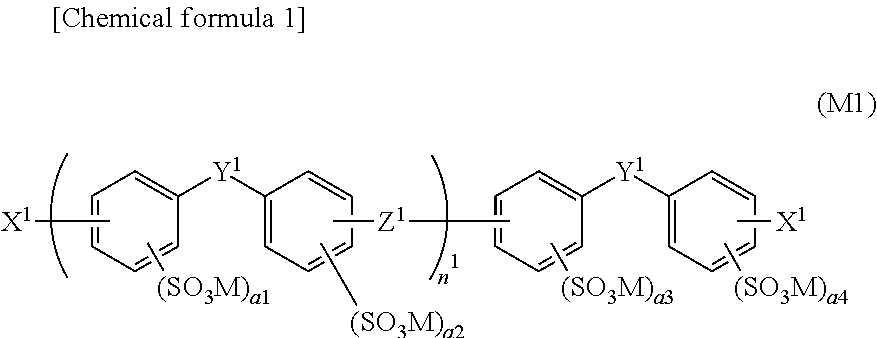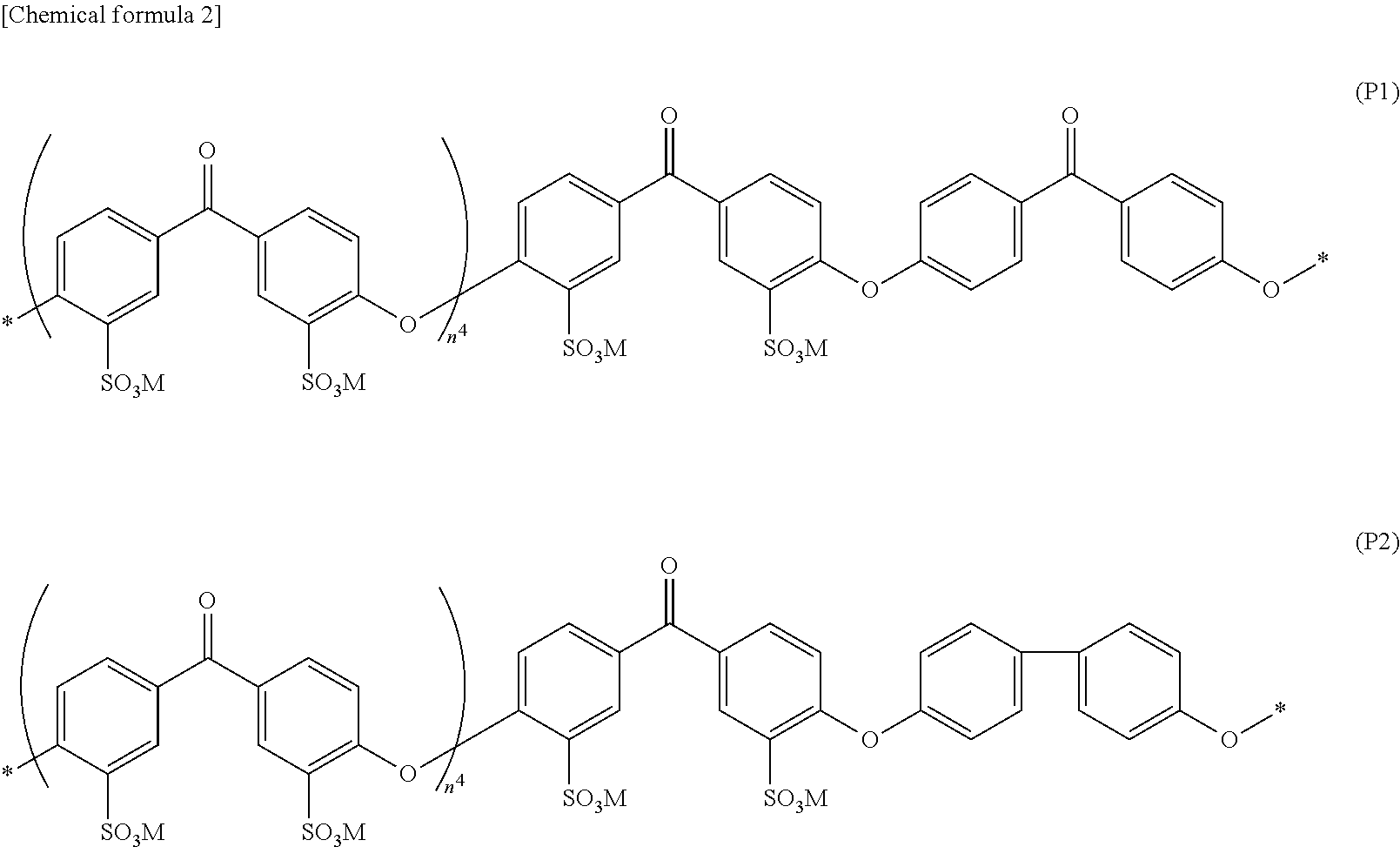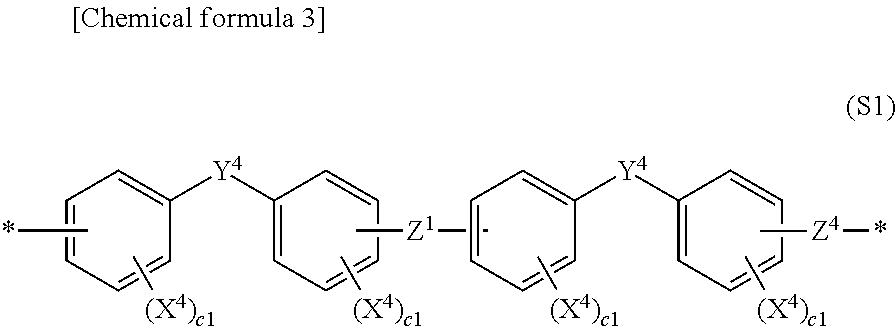Aromatic sulfonic acid derivative, sulfonic acid group-containing polymer, block copolymer, polymer electrolyte material, polymer electrolyte form article, and polymer electrolyte fuel cell
a technology of sulfonic acid derivatives and sulfonic acid group-containing polymers, which is applied in the direction of cell components, conductors, non-metal conductors, etc., can solve the problems of reducing film mechanical strength and physical durability, high price of nafion (registered trademark), and large fuel crossover (fuel permeability). , to achieve the effect of high proton conductivity, high mechanical strength and chemical stability, and high outpu
- Summary
- Abstract
- Description
- Claims
- Application Information
AI Technical Summary
Benefits of technology
Problems solved by technology
Method used
Image
Examples
synthesis example 1
Synthesis of 2,2-bis(4-hydroxyphenyl)-1,3-dioxolane (K-DHBP) which is Represented by the General Formula (G1) Given Below
[0209]
[0210]In a 500 mL flask equipped with a stirrer, thermometer, and distillation tube, 49.5 g of 4,4′-dihydroxy benzophenone, 134 g of ethylene glycol, 96.9 g of trimethyl orthoformate, and 0.50 g of p-toluene sulfonic acid monohydrate were fed and dissolved. Then, the solution was maintained at 78 to 82° C. for 2 hours under continued stirring. Furthermore, the inner temperature was gradually raised up to 120° C., and heating was continued until the distillation of methyl formate, methanol, and trimethyl orthoformate stopped completely. The reaction solution was cooled to room temperature and diluted with ethyl acetate, and the organic layer was washed with 100 mL of a 5% potassium carbonate aqueous solution and separated, followed by evaporating the solvent. To the residual material, 80 mL of dichloromethane was added to precipitate a crystalline material, w...
synthesis example 2
Synthesis of disodium-3,3′-disulfonate-4,4′-difluoro benzophenone which is Represented by the General Formula (G2) Given Below
[0211]
[0212]First, 109.1 g of 4,4′-difluoro benzophenone (reagent manufactured by Aldrich) was reacted in 150 mL of fuming sulfuric acid (50% SO3) (reagent manufactured by Wako Pure Chemical Industries, Ltd.) at 100° C. for 10 hours. Subsequently, the solution was added little by little to a large amount of water and neutralized with NaOH, and 200 g of sodium chloride was added to precipitate the synthesized material. The resulting precipitate was separated by filtration, and recrystallized with ethanol aqueous solution to obtain disodium-3,3′-disulfonate-4,4′-difluorobenzophenone, which is represented by the general formula (G2). It had a purity of 99.3%. Its structure was confirmed by 1H-NMR. The quantities of impurities were analyzed by capillary electrophoresis (for organic substances) and ion chromatography (for inorganic substances).
example 1
Synthesis of an Aromatic Sulfonic Acid Derivative as Represented by the Formula (G3) Given Below
[0213]
[0214]First, 160 g diphenyl ether (reagent manufactured by Tokyo Chemical Industry Co., Ltd.) and 317 g of aluminum chloride were dissolved in 800 mL of dichloromethane, and then a dichloromethane solution (200 mL) containing 358 g of 4-fluorobenzoyl chloride was dropped at 0° C., followed by gradual heating to room temperature and reaction for 4 hours. The solution was diluted with dichloromethane and washed with water, methanol, and hexane to obtain 350 g of a difluoro compound. Then, 350 g of the resulting difluoro compound was reacted in 1,130 g fuming sulfuric acid (30% SO3) (reagent manufactured by Wako Pure Chemical Industries, Ltd.) at 115° C. for 20 hours. The solution was added little by little to a large amount of water and neutralized with NaOH, followed by precipitating sodium sulfate with ethanol three times to remove it, thereby obtaining an aromatic sulfonic acid der...
PUM
| Property | Measurement | Unit |
|---|---|---|
| operating temperature | aaaaa | aaaaa |
| weight ratio | aaaaa | aaaaa |
| temperature | aaaaa | aaaaa |
Abstract
Description
Claims
Application Information
 Login to View More
Login to View More - R&D
- Intellectual Property
- Life Sciences
- Materials
- Tech Scout
- Unparalleled Data Quality
- Higher Quality Content
- 60% Fewer Hallucinations
Browse by: Latest US Patents, China's latest patents, Technical Efficacy Thesaurus, Application Domain, Technology Topic, Popular Technical Reports.
© 2025 PatSnap. All rights reserved.Legal|Privacy policy|Modern Slavery Act Transparency Statement|Sitemap|About US| Contact US: help@patsnap.com



